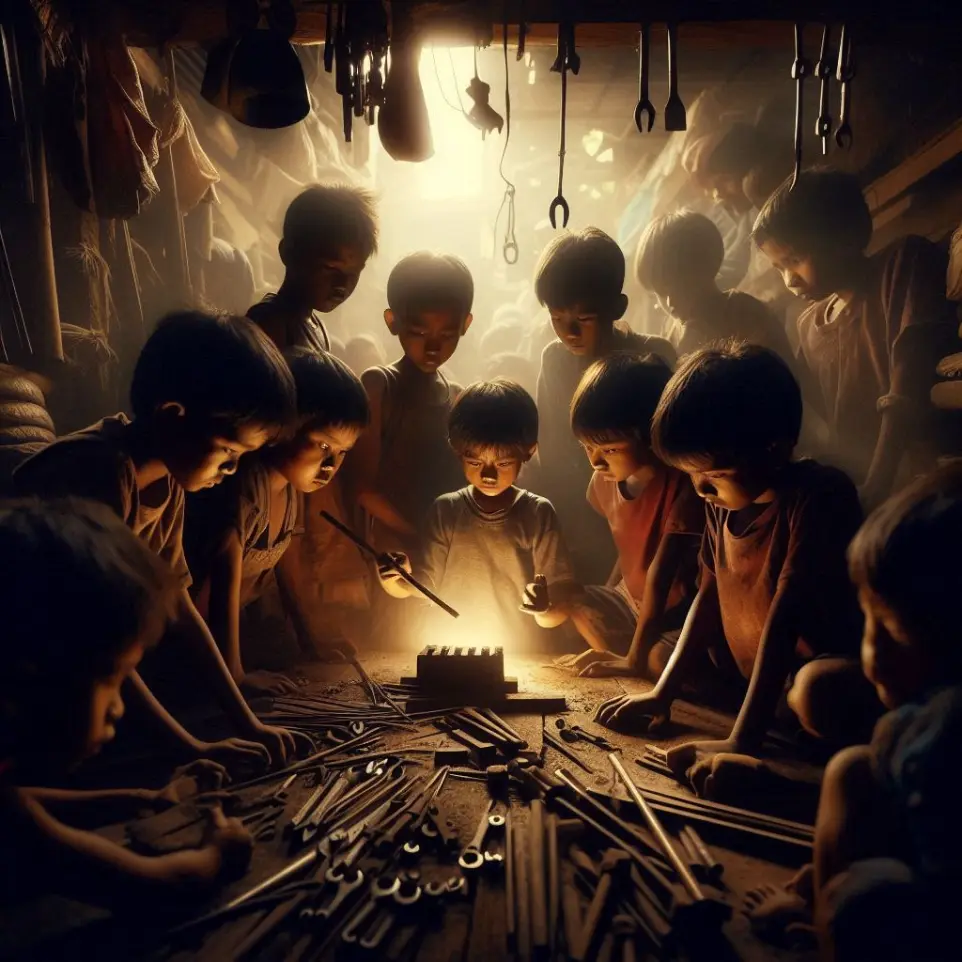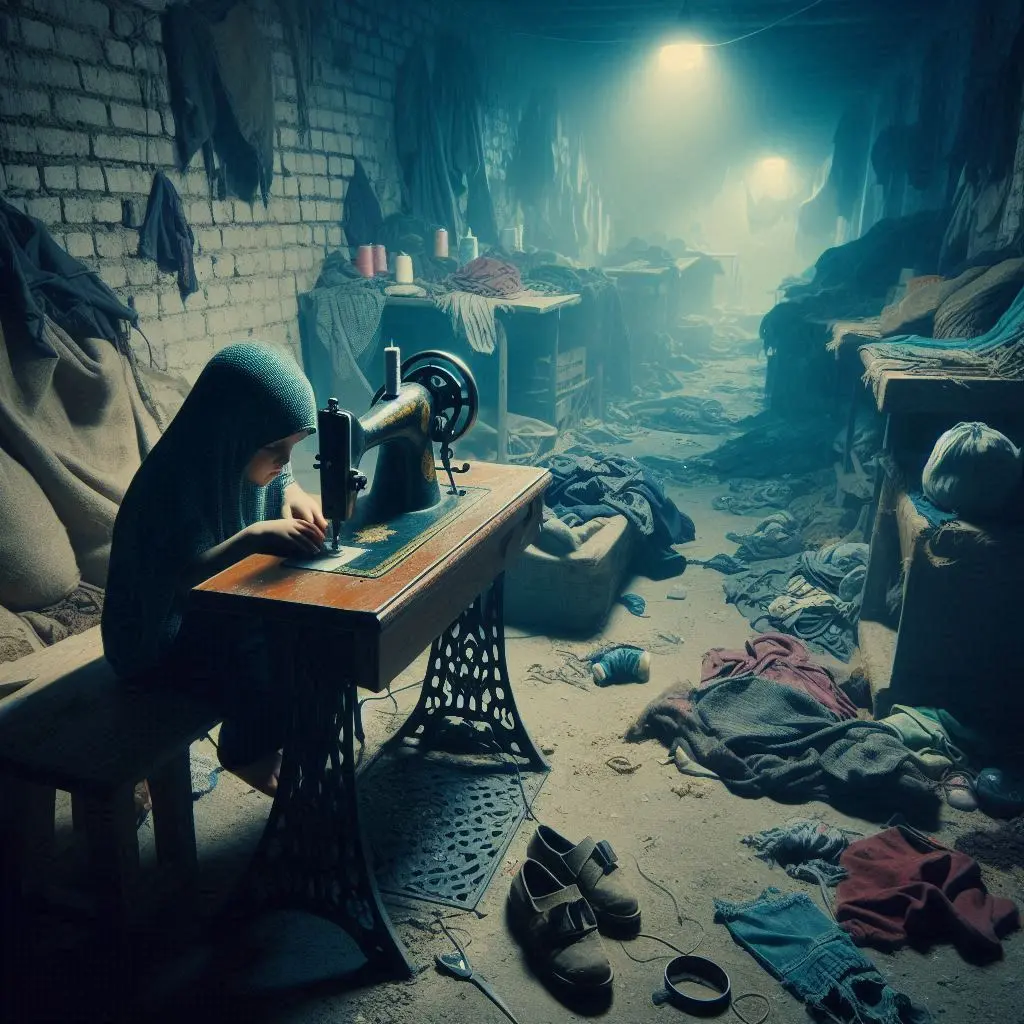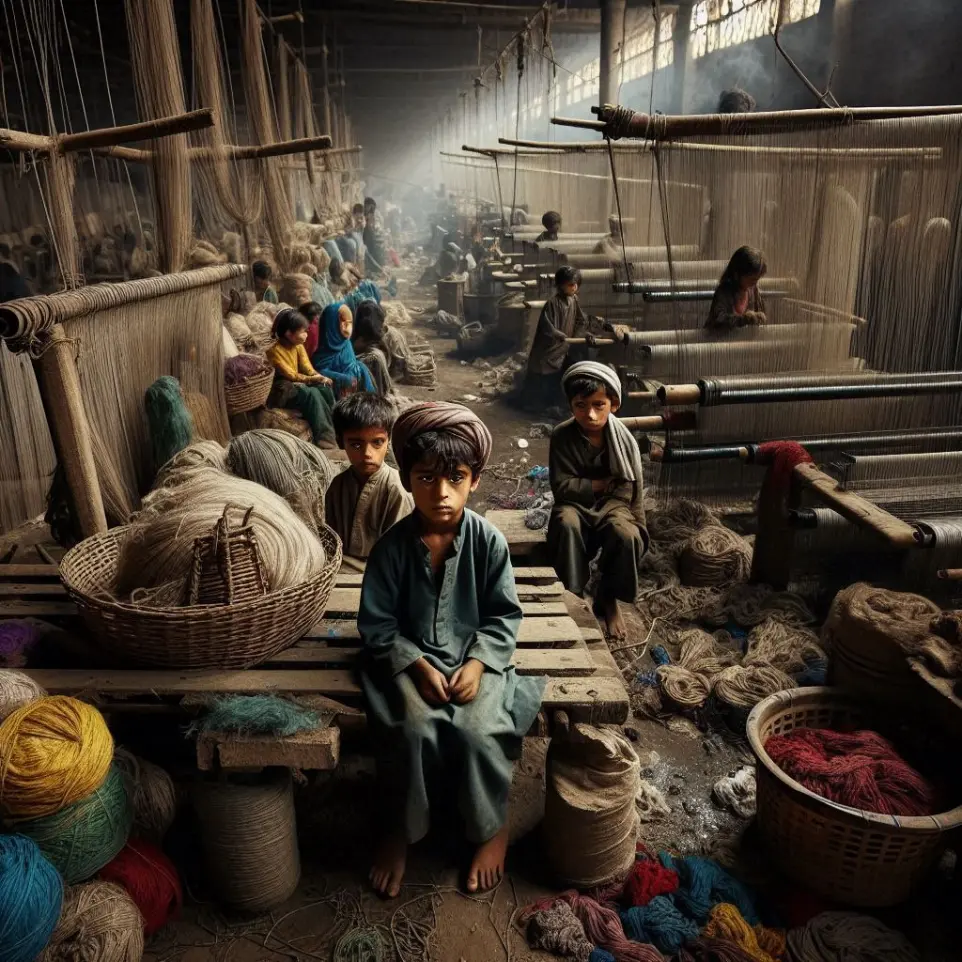





Child labour: The grim reality behind the global economy
On this site you will find a comprehensive analysis of human rights globally. Dive into our main article "Child Labour: The Grim Reality Behind the Global Economy" and discover the shocking truth behind this issue. Get ready to explore economic and social rights in depth, and join the fight for a more just world.
Introduction
Child labour is a problem that significantly affects the global economy. Although it may seem like a solution to cheap labour, in the long term it has negative consequences for both children and the economy as a whole. Working children are deprived of proper education, which limits their potential to contribute to economic growth in the future. Furthermore, child labour can perpetuate the cycle of poverty, as these children have fewer opportunities to break the cycle and improve their living conditions in the future.
In economic terms, child labour can lead to a decrease in productivity in the long term, as working children do not have the opportunity to acquire skills and education that will enable them to contribute more significantly to the economy in the future. In addition, child labour can lead to unfair competition in the labour market, as children are more likely to accept lower wages and precarious working conditions, which can negatively affect adult workers. Child labour not only negatively affects the children who are forced to work, but also has a significant impact on the global economy in the long term.
Statistics on child labour are alarming and highlight the magnitude of this problem worldwide. According to the International Labour Organisation (ILO), it is estimated that approximately 152 million children in the world are involved in child labour, of which nearly half perform hazardous work that puts their health and well-being at risk.
In addition, it is estimated that around 70% of working children do so in the agricultural sector, while the remainder are distributed in other sectors such as mining, manufacturing, construction and services. These figures reflect the great diversity of contexts in which child labour occurs, which requires specific approaches adapted to each situation. It is important to highlight that child labour not only affects developing countries, but also occurs in developed economies, which underlines the need to address this problem at a global level.
In response to the problem of child labour, the international community has established a number of laws and regulations to protect children and ensure their rights. The United Nations Convention on the Rights of the Child is an international treaty that sets out the fundamental rights of children, including the right to protection from labour exploitation.
In addition, the ILO has developed the Minimum Age Convention, which sets the minimum age at which a child may be employed, as well as specific conditions to protect working children. These international regulations seek to ensure that all children have the opportunity to grow up in a safe environment, receive an education and develop fully without the burden of child labour. Despite these regulations, child labour remains a reality in many parts of the world, underscoring the need for continued commitment to enforcing these laws and protecting children's rights globally.
Child labour is the result of a complex interaction of economic, social and cultural factors that combine to force children to work in dangerous and detrimental conditions for their development. Economic factors include extreme poverty, lack of employment opportunities for adults and the demand for cheap labour in sectors such as agriculture, manufacturing and mining. In many cases, impoverished families are forced to send their children to work in order to survive.
In addition, social factors such as lack of access to quality education, gender discrimination and migration contribute significantly to child labour. The lack of effective labour laws and their inadequate enforcement also play a crucial role in perpetuating this problem. The pressure of tradition and cultural norms that normalise child labour in certain communities also makes it difficult to eradicate this practice.
Child labour is the result of a network of factors ranging from poverty and lack of economic opportunities to discrimination and lack of access to education. Addressing this problem requires not only economic measures, such as the creation of decent employment for adults, but also profound social and cultural changes that promote the protection of children's rights and their access to education and a safe environment.

Child labour in the global economy
Child labour is a problem that affects millions of children around the world. It is defined as any work that deprives children of their childhood, their potential and their dignity, and that is harmful to their physical and psychological development. This phenomenon includes work that deprives children of education, exposes them to physical and mental dangers, and forces them to assume responsibilities that are not appropriate for their age. The International Labour Organization (ILO) estimates that around 152 million children are victims of child labour worldwide, of whom almost half are engaged in hazardous work. This reality is present in numerous sectors, including agriculture, mining, manufacturing, construction and the provision of services. The complexity and seriousness of child labour implies the need for coordinated global action to address this scourge and protect the fundamental rights of children.
The relationship between poverty and child labour is undeniable. In many cases, families living in extreme poverty are forced to send their children to work to contribute to the household's livelihood. The lack of access to basic services, such as education and health care, as well as the scarcity of decent work opportunities for adults, pushes children to take on labour roles at an early age.
In addition, extreme poverty can lead to situations where children are exploited in labour, whether in the form of unfair wages, long working hours or unsafe working conditions. This reality reflects the need to address both poverty and child labour in a comprehensive manner, implementing policies that promote sustainable economic development, social protection and equitable access to education and health.
It is essential to understand that the eradication of child labour not only requires specific measures targeting children, but also strategies that address the root causes of poverty and inequality.
Child labour exploitation is one of the most worrying manifestations of child labour in the global economy. Children who perform hazardous work, are not protected by labour laws or are subjected to abusive situations, face devastating consequences for their health, well-being and development.
The lack of regulation and supervision in certain economic sectors, as well as the demand for cheap labour, contribute to the perpetuation of child labour exploitation. This is aggravated by the participation of children in global supply chains, where their work is made invisible and their rights are violated in the name of economic profitability.
Combating child labour exploitation involves the implementation and effective enforcement of laws and regulations that protect children's rights, as well as the promotion of ethical business practices that ensure that products and services are not tainted by child labour.
Child labour has a devastating impact on children's education and development. When children are forced to work instead of attending school, they are deprived of the opportunity to acquire knowledge and skills that are critical to their future. This impact is reflected in declining literacy rates and limited access to formal education. In addition, child labor disrupts children's cognitive and emotional development as they are forced to take on work responsibilities that are not appropriate for their age.
Lack of education and proper development due to child labor perpetuates a cycle of poverty and limits children's opportunities to escape poverty. Education is the key to breaking the cycle of poverty, and when children are denied this opportunity, they are condemned to live in precarious conditions throughout their adult lives. Furthermore, child labor often leads to the perpetuation of the same situation in future generations, as children who work instead of attending school have fewer tools to provide their own children with a better quality of life.
Child labour has a disastrous impact on children's education and development, perpetuating poverty and limiting opportunities for future generations. It is crucial to address this issue from a global perspective and take concrete measures to ensure that all children have access to adequate education and the opportunity to develop fully.
Analysis of global human rights
Respecting and protecting labour rights, particularly children's rights, is essential to ensuring a fair and sustainable global economy. Eradicating child labour is an ethical and legal imperative that requires collective action at the global level. In this context, a thorough exploration and in-depth analysis of the current situation is crucial to understanding the challenges and opportunities in protecting children's labour rights.
Child labour rights, enshrined in the Universal Declaration of Human Rights and the Convention on the Rights of the Child, establish that all children have the right to be protected from any form of labour exploitation. However, millions of children worldwide are forced to work in conditions that are detrimental to their health, development and well-being. Child exploitation is intertwined with poverty, lack of access to education and social vulnerability, perpetuating a cycle of injustice.
It is essential that governments, international organisations, businesses and society as a whole commit to protecting and promoting children's labour rights. This involves implementing effective policies, creating monitoring mechanisms and applying sanctions for those who violate these rights.
In addition, it is necessary to provide support and opportunities to vulnerable families and communities so that children can access education, adequate food and a safe environment that allows them to develop fully without resorting to child labour.
Corporations have a significant influence on the global economy and therefore have a responsibility to ensure that their supply chains are free of child labour. It is essential that companies apply ethical standards across their operations and demand the same from their suppliers. This involves conducting regular audits, collaborating with organisations dedicated to protecting children's rights and being transparent about their labour practices.
In addition, corporations can play an active role in investing in community, educational and development programmes that contribute to eradicating the underlying causes of child labour. By taking a proactive and ethical approach, companies can be agents of positive change in the fight against child labour globally.
Despite the efforts made, the effective implementation of child protection policies faces various challenges. These include lack of financial resources, corruption, labour informality, lack of coordination between the actors involved and the need for stronger legislation and its effective implementation.
It is crucial to address these challenges in a comprehensive and collaborative manner, involving governments, international organisations, businesses, trade unions and civil society. Only through a multidimensional and coordinated approach will it be possible to make significant progress in eradicating child labour and effectively protecting children's labour rights in the global economy.
Awareness and education play a key role in preventing child labour globally. Raising awareness about the negative consequences of child labour and promoting the importance of education is crucial to generating meaningful change in society. Through educational campaigns, communities can be informed about the fundamental rights of children and the long-term implications of child labour on human development.
Education not only provides children with the tools necessary for a more prosperous future, but also acts as a means to remove them from dangerous and exploitative work environments. By promoting education, children are given the opportunity to break the cycle of poverty and contribute significantly to the sustainable development of their communities.
In addition, raising awareness among consumers and businesses about the issue of child labour can impact purchasing decisions and labour practices. When consumers are informed about the presence of child labor in the supply chain of certain products, they can put pressure on companies to adopt more ethical and responsible practices. In this way, awareness and education become powerful tools to address and prevent child labor in the global economy.
Long-term consequences of child labour
Child labour not only affects children's physical well-being, but also their mental and emotional health. Children who are forced to work at an early age are exposed to hazardous working conditions and often perform tasks that are not appropriate for their physical development. This can result in long-term injuries, illnesses and disabilities. In addition, the emotional and psychological burden of taking on work responsibilities at an early age can lead to stress, anxiety, depression and trauma that last into adulthood.
Exposure to hazardous work situations, gruelling work days and lack of access to adequate medical care can have devastating effects on children's health, limiting their ability to grow and develop healthily. This not only affects their quality of life in the present, but can also have long-term repercussions on their overall well-being and ability to contribute to society in the future.
Child labour not only poses a serious threat to children's physical and mental health, but also perpetuates a cycle of disadvantage that affects their overall development and potential for a prosperous future.
Child labour is a significant contributor to the perpetuation of the cycle of poverty and inequality. When children are forced to leave school to work, they are deprived of the opportunity to receive an education that will enable them to acquire skills and knowledge necessary to access better job opportunities in the future. This lack of education condemns children to low-paid jobs and precarious working conditions, which in turn hinders their ability to escape poverty and marginalisation.
Lack of access to education also limits social mobility and perpetuates intergenerational inequality, as children who work instead of studying have little chance of breaking the cycle of poverty in which their families are trapped. This situation creates a dynamic in which poverty and lack of opportunities are transmitted from one generation to the next, keeping families trapped in the same precarious situation.
In short, child labour not only has an immediate impact on children's lives, but also contributes to the reproduction of poverty and inequality over time, perpetuating a cycle of marginalisation that affects the most vulnerable communities globally.
Child labour not only affects children and their families, but also has social and economic repercussions on a global scale. Child labour exploitation undermines labour standards and fosters unfair competition in the market, which can lead to lower wages and working conditions for adult workers. In addition, lack of access to adequate education limits the innovation and development potential of communities, which in turn impacts on economic productivity and competitiveness at national and international levels.
The presence of child labour in the supply chains of global companies also raises ethical and corporate social responsibility challenges, as it involves complicity in the exploitation of children for economic gain. This can affect the reputation of companies and generate rejection by consumers and society at large.
Child labour not only has devastating effects at the individual and family level, but also has significant implications for society and the global economy, undermining labour rights, equity and sustainable development worldwide.
Actions and measures to eradicate child labour
Support and rehabilitation programmes play a fundamental role in the recovery process of children who have been affected by child labour. These programmes are designed to offer medical, psychological and educational care to children who have suffered the adverse consequences of child labour. Through the provision of comprehensive services, children can receive the necessary support to overcome the physical and emotional consequences resulting from their participation in age-inappropriate work activities.
In addition, these programmes often include the participation of the families of the affected children, with the aim of providing a holistic approach that addresses the underlying causes of child labour. By providing a safe, educational and supportive environment, the aim is to restore the comprehensive well-being of children and ensure their full development.
It is essential that these programmes receive the support of governmental, non-governmental and civil society organisations, as well as adequate financial resources for their effective implementation and long-term sustainability.
International alliances play a crucial role in the fight against child labour at a global level. By joining forces, governments, international organisations, businesses and civil society can collaborate to implement coordinated strategies to address this challenge. These alliances allow for the sharing of good practices, resources and expertise, resulting in a more effective and sustainable approach to eliminating child labour.
In addition, international alliances contribute to the promotion of ethical labour standards and the monitoring of their compliance in the global supply chain. By fostering corporate responsibility and transparency, they seek to prevent the involvement of children in hazardous and exploitative work.
International cooperation can also promote the adoption and implementation of strong legal frameworks that prohibit child labour and promote universal access to quality education. These alliances are essential to ensure that the protection of children's rights is a priority on the global agenda and to promote significant change in the eradication of child labour.
Education plays a fundamental role in the prevention of child labour by offering children real opportunities for development and growth. By ensuring access to quality and relevant education, children's ability to build a promising future, free from labour exploitation, is strengthened.
Promoting inclusive and equitable education contributes to raising awareness in communities about the risks associated with child labour and empowering children and their families to make informed decisions about their future. Likewise, education provides children with the skills and knowledge necessary to access decent and sustainable work opportunities in the future, breaking the cycle of poverty and exploitation.
It is important to highlight that quality education does not only involve the acquisition of academic knowledge, but also the development of socio-emotional skills, the promotion of ethical values and the encouragement of active participation in society. Through education, the foundations are laid for building an enabling environment that protects and promotes the rights of all children, thus contributing to the eradication of child labour worldwide.
Civil society and non-governmental organizations play a fundamental role in the fight against child labor in the global economy. They work tirelessly to raise awareness of the dangers and consequences of child labor, advocating for the implementation of policies and programs that protect children from labor exploitation.
In addition, non-governmental organizations work closely with governments and other institutions to monitor and report violations of children's labor rights, providing legal and social support to victims and their families. Through awareness-raising campaigns, research and direct actions, these entities contribute significantly to the eradication of child labor in sectors such as agriculture, the textile industry, mining and others.
The work of civil society and non-governmental organizations is crucial to generating a lasting impact on the protection of children's rights, promoting the adoption of effective measures at local, national and international levels to combat child labour and guarantee a dignified future for all children around the world.
Conclusions
Child labour remains a persistent challenge in the global economy, despite efforts to eradicate it. Worldwide, millions of children continue to be exploited in various industries, representing a flagrant violation of their human rights. Addressing this problem requires a comprehensive approach that addresses the complex underlying causes, such as poverty, lack of access to education and precarious working conditions.
It is essential that the international community step up its efforts to combat child labour, through effective policy implementation and constant monitoring of global supply chains. In addition, labour laws and regulations must be strengthened in all countries, ensuring that there are adequate sanctions for those who perpetuate this abusive practice.
Public awareness plays a crucial role in the fight against child labour, as knowledge and understanding of this problem can drive concrete actions at individual and collective levels. Society as a whole must raise its voice to demand meaningful change and the protection of children's rights around the world.
The eradication of child labour at the global level continues to face significant challenges. One of the main obstacles is the complexity of global supply chains, which often involve multiple actors and countries. This makes it difficult to effectively monitor and enforce labour standards at all stages of production and distribution of goods and services. In addition, the persistence of poverty and the lack of economic alternatives for families in vulnerable situations contribute to the perpetuation of child labour.
Another important challenge lies in the need for stronger international coordination, which allows for the exchange of information and good practices between countries. The lack of cooperation and harmonization of approaches hinders the implementation of effective strategies to address child labour on a global scale.
To overcome these challenges, it is imperative that governments, international organizations, businesses and civil society work together to establish concrete and sustainable measures that accelerate the eradication of child labour in the global economy.
International cooperation plays a fundamental role in the fight against child labour in the global economy. Coordinated efforts between countries, international organisations and private actors are essential to effectively address this problem. Collaboration in the implementation and monitoring of labour standards, as well as in the creation of support programmes for families in vulnerable situations, can significantly contribute to the reduction of child labour.
Furthermore, public awareness is a determining factor in generating a change in attitude and behaviour in society. Educational campaigns, awareness-raising initiatives and the dissemination of truthful information about the consequences of child labour are powerful tools to mobilise the population against this practice. Knowledge and understanding of the causes and consequences of child labour can generate greater commitment to its eradication, promoting the adoption of concrete measures at the individual and collective level.
Despite the efforts made, the effective implementation of child protection policies faces various challenges. These include lack of financial resources, corruption, labour informality, lack of coordination between the actors involved and the need for stronger legislation and its effective implementation.
It is crucial to address these challenges in a comprehensive and collaborative manner, involving governments, international organisations, businesses, trade unions and civil society. Only through a multidimensional and coordinated approach will it be possible to make significant progress in eradicating child labour and effectively protecting children's labour rights in the global economy.
Eliminating child labour would have a significant and positive impact on economic and social rights globally. By ensuring that children have access to quality education and can develop in a safe and healthy environment, the foundations for more just and equal societies would be laid. Child protection is essential for the sustainable future of the global economy, as children are the foundation of future generations.
In addition, eliminating child labour would contribute to the reduction of poverty and inequality, while promoting sustainable development. By freeing children from labour exploitation, they are given the opportunity to reach their full potential, which in turn strengthens the economic and social foundation of communities and countries as a whole.
The eradication of child labour is a moral imperative and a fundamental requirement for achieving truly sustainable economic and social development globally. Only through international cooperation, public awareness and collective commitment can we achieve a world in which the rights of every child are respected and protected, thus laying the foundations for a more equitable and prosperous future.

 IHRO NEWS
IHRO NEWS